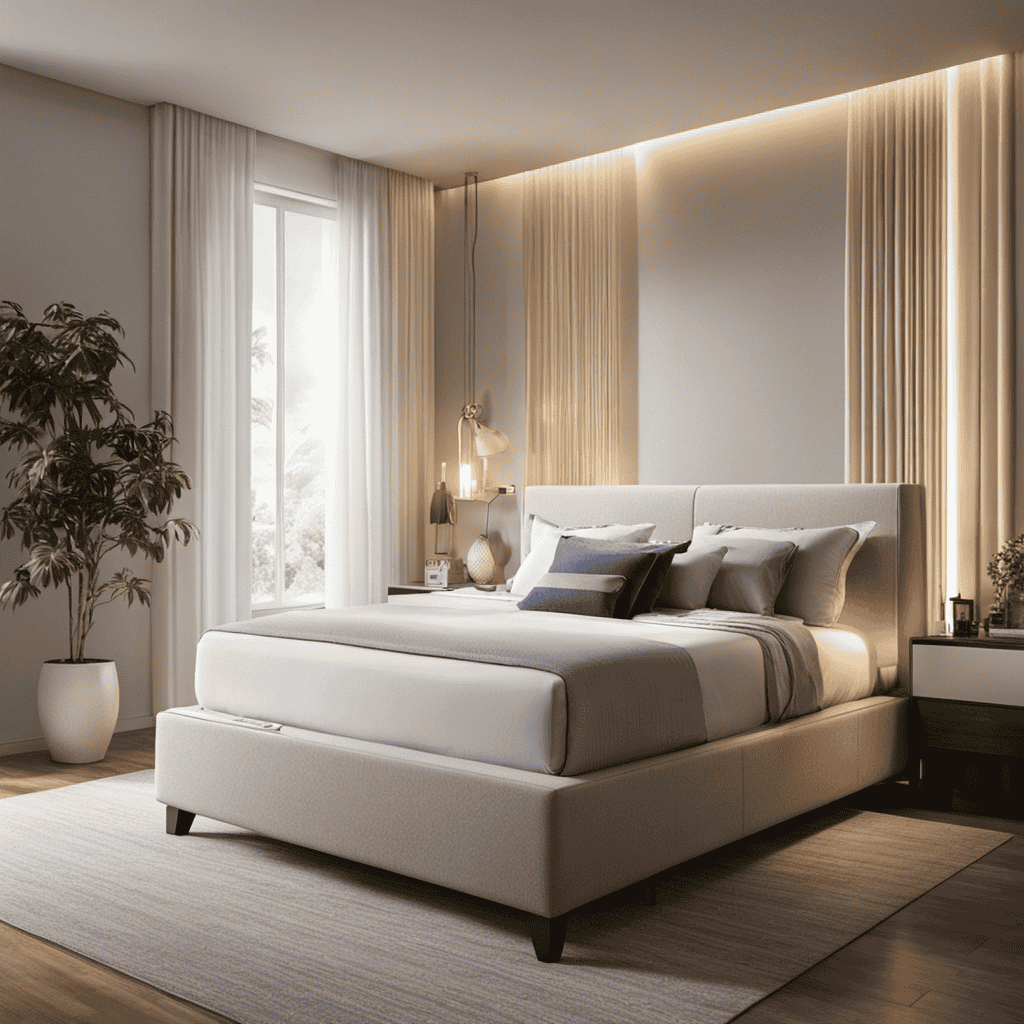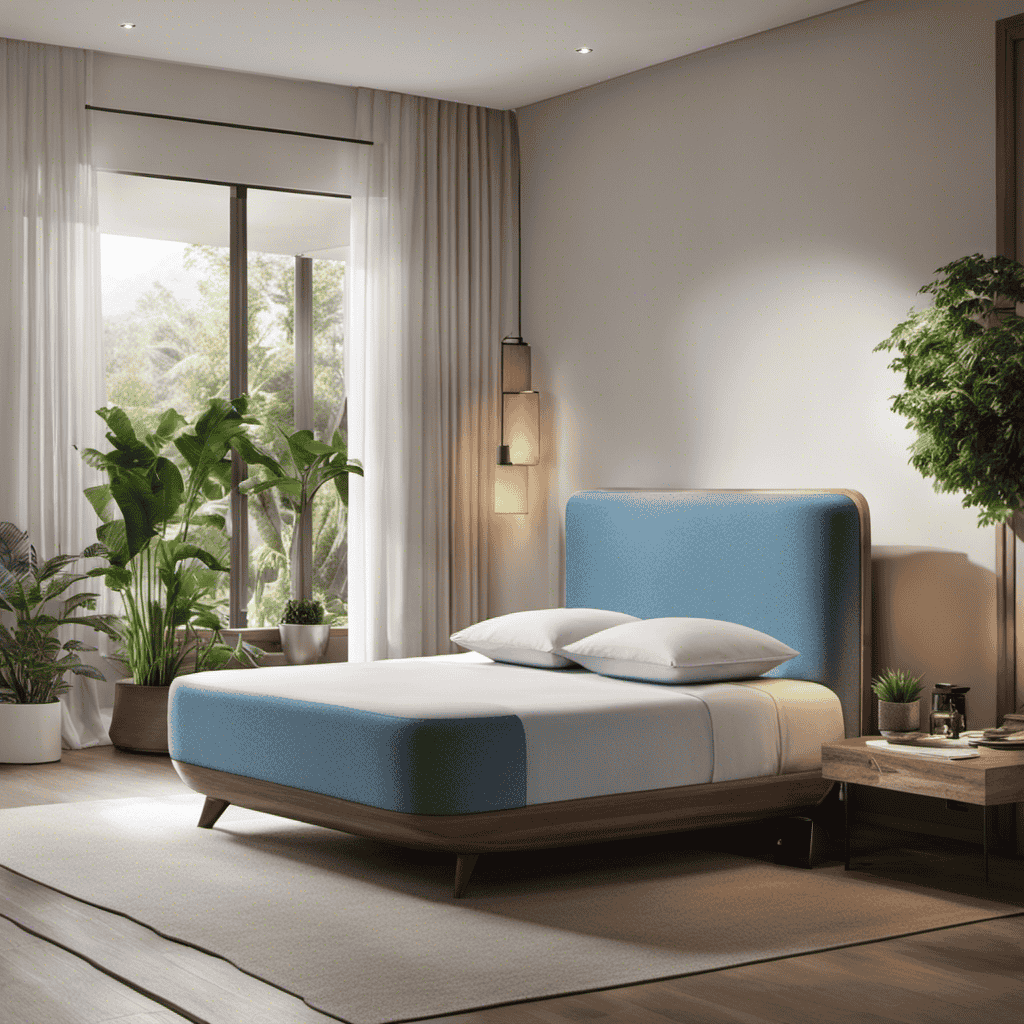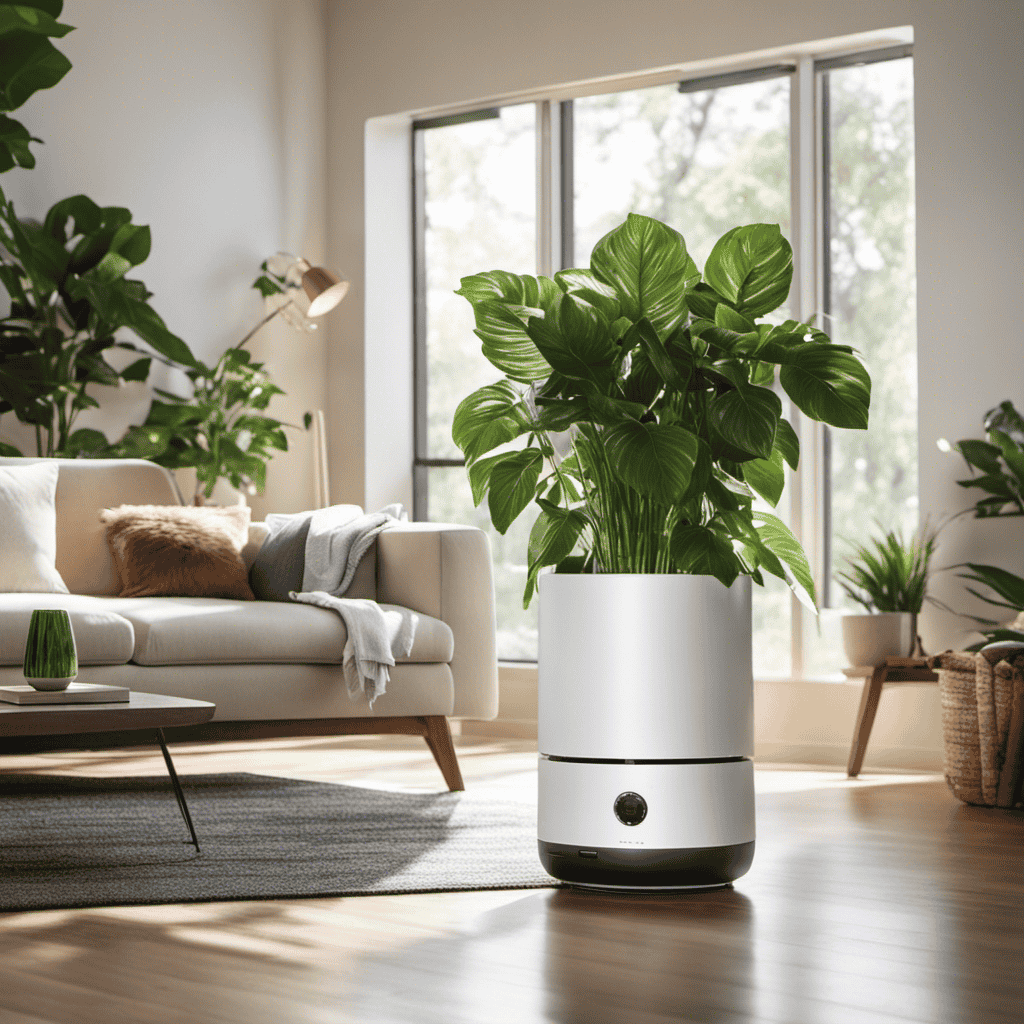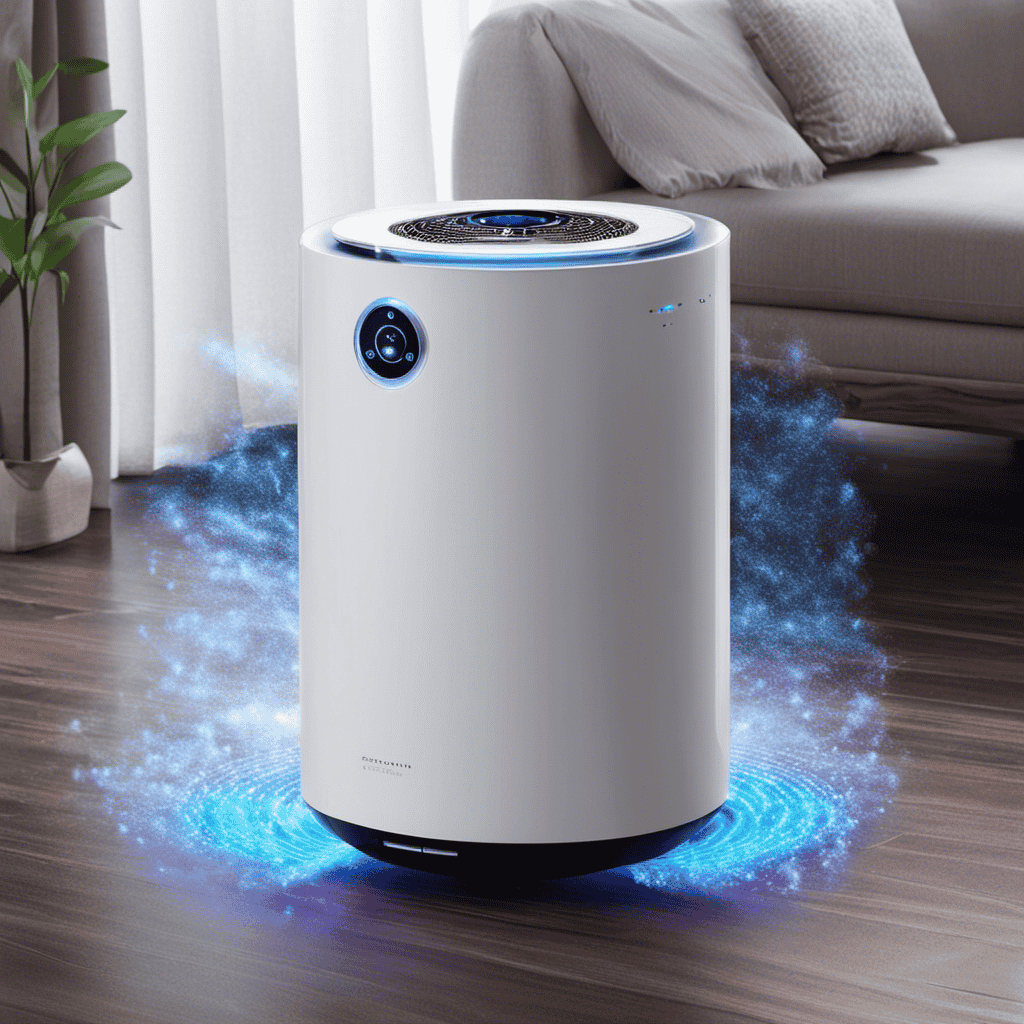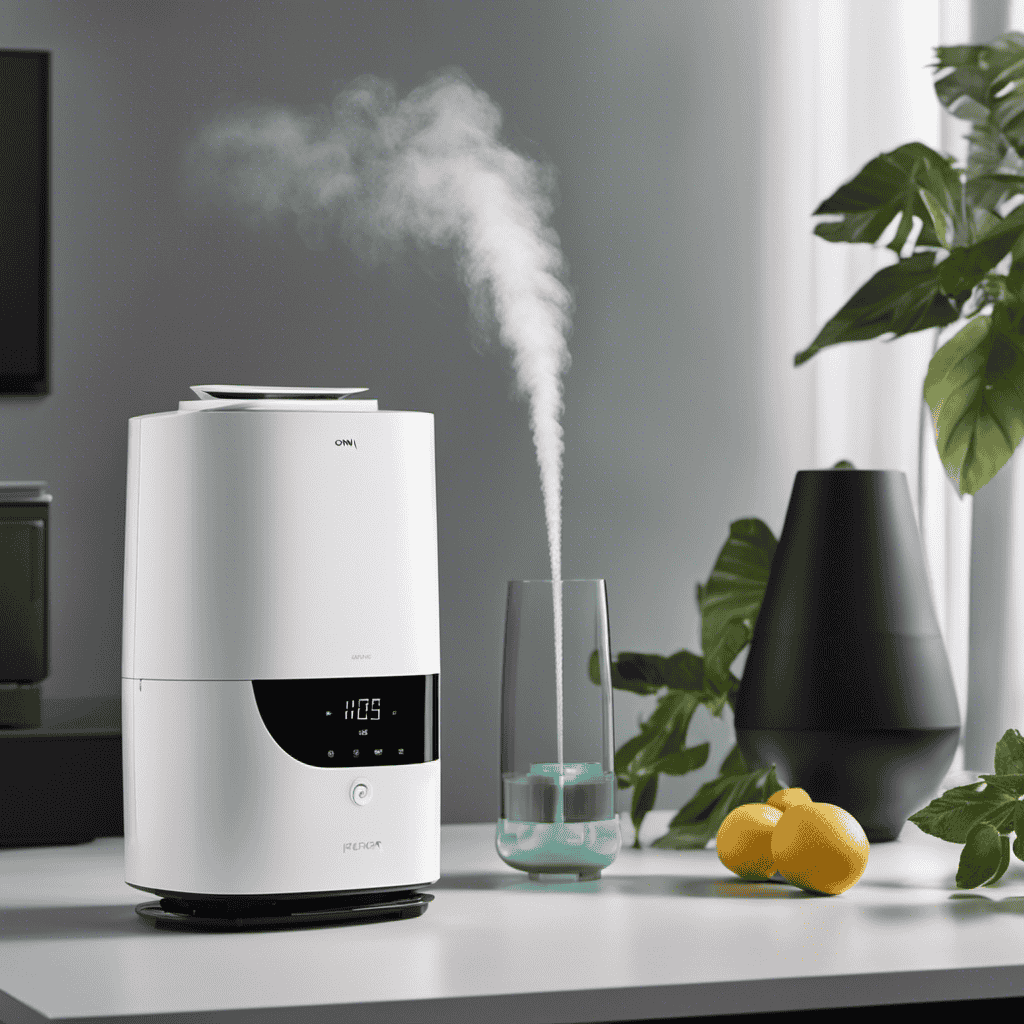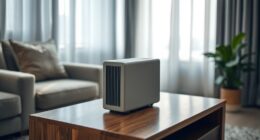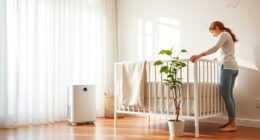Which air purifier is most effective for managing allergies and asthma?
I’ve done the research and found the top recommendations for you.
Air purifiers play a crucial role in providing relief from allergies and asthma symptoms.
In this article, I’ll explain the key features to look for in an air purifier, such as HEPA filters and activated carbon filters.
I’ll also compare different brands and models, share consumer reviews, and help you understand CADR ratings.
Let’s dive in and find the perfect air purifier for your needs.
Key Takeaways
- Air purifiers with HEPA filters effectively remove common allergens like pollen, dust mites, pet dander, and mold spores from the air.
- Air purifiers reduce asthma symptoms and improve indoor air quality by eliminating allergens and reducing triggers in the environment.
- Activated carbon filters in air purifiers are highly effective in removing unwanted odors and capturing allergens, as well as neutralizing chemical pollutants.
- UV light technology in air purifiers can destroy microorganisms that trigger asthma attacks and allergic reactions, but it should be used in conjunction with other purification methods and should not produce ozone.
Understanding Allergies and Asthma
Understanding allergies and asthma can help you choose the best air purifier.
Allergies and asthma are both respiratory conditions that can be triggered by various factors, including allergens and irritants in the air.
Common allergens such as pollen, dust mites, pet dander, and mold spores can cause allergic reactions and worsen asthma symptoms.
These triggers can lead to coughing, wheezing, shortness of breath, and other respiratory issues.
By understanding the specific triggers that affect you or your loved ones, you can select an air purifier that effectively removes these allergens from the air, providing relief and improving indoor air quality.
Air purifiers with HEPA filters are particularly beneficial for allergies and asthma as they can capture small particles, such as pollen and pet dander, that often trigger these conditions.
With this knowledge, let’s explore the importance of air purifiers for allergies and asthma.
The Importance of Air Purifiers for Allergies and Asthma
As someone who suffers from allergies and asthma, I understand the importance of finding relief through air purification.
Air purifiers have been proven effective in reducing asthma symptoms and providing relief by removing airborne allergens and irritants from the indoor environment.
Additionally, these purifiers help prevent allergies by capturing and eliminating allergens such as dust mites, pollen, and pet dander, thus improving the overall air quality in your home.
Asthma Relief Through Purification
If you have asthma, using an air purifier can provide you with relief. Air purifiers are designed to remove allergens and irritants from the air, which can be especially beneficial for individuals with asthma.
One of the main benefits of using an air purifier is that it helps to reduce asthma triggers in the environment. These triggers can include dust mites, pollen, pet dander, and mold spores, all of which can worsen asthma symptoms. By capturing and filtering these particles, air purifiers can help to create a cleaner and healthier indoor environment, allowing individuals with asthma to breathe easier.
In the next section, we will explore how air purifiers can also play a role in allergy prevention and provide relief for those with allergies.
Allergy Prevention With Purifiers
Using an air purifier can help prevent allergies by filtering out allergens in the air, creating a healthier indoor environment.
Air purifiers are highly effective in reducing allergy symptoms. They capture and remove common allergens such as dust mites, pollen, pet dander, and mold spores from the air. These microscopic particles can trigger allergic reactions and worsen asthma symptoms.
By removing these allergens, air purifiers can significantly improve indoor air quality and provide relief for allergy sufferers.
When choosing an air purifier for allergies, there are key features to look for. A HEPA (High-Efficiency Particulate Air) filter is capable of capturing up to 99.97% of particles as small as 0.3 microns. This feature is crucial in ensuring the removal of allergens from the air.
Other important features include a large coverage area, multiple fan speeds, and a filter replacement indicator. These features enhance the performance and convenience of the air purifier.
Transitioning to the next section, let’s explore these key features in more detail.
Key Features to Look for in Air Purifiers for Allergies and Asthma
When considering air purifiers for allergies and asthma, two key features to look for are filter efficiency ratings and noise level considerations.
Filter efficiency ratings are important because they determine how effectively the purifier can remove allergens and asthma triggers from the air. A higher filter efficiency rating means a higher ability to capture and trap particles, providing cleaner air for those with allergies and asthma.
Noise level considerations are also crucial as a loud purifier can be disruptive and bothersome, especially when trying to sleep or concentrate. Look for purifiers with lower noise levels to ensure a peaceful and comfortable environment.
Filter Efficiency Ratings
The best air purifiers for allergies and asthma have high filter efficiency ratings. These ratings indicate how effectively an air purifier can remove allergens and asthma triggers from the air. Air purifiers with high filter efficiency ratings use advanced air purifier technology to capture even the smallest particles, such as pollen, dust mites, pet dander, and mold spores.
Here are the benefits of air purification with high filter efficiency:
-
Improved air quality: High filter efficiency ensures that the air you breathe is clean and free from allergens and asthma triggers.
-
Reduced symptoms: By removing airborne particles, air purifiers can help alleviate allergy and asthma symptoms, such as sneezing, coughing, and wheezing.
Investing in an air purifier with high filter efficiency ratings is a smart choice for those with allergies and asthma, as it can significantly improve the quality of their indoor air and provide relief from symptoms.
Noise Level Considerations
Considering noise level is important when choosing an air purifier for those with allergies and asthma. Silent operation is crucial, especially for individuals who need a quiet environment for sleep. When it comes to air purifiers, a sleep-friendly design becomes essential.
Look for models that prioritize silent operation and have features that minimize noise. These air purifiers are designed to work quietly, ensuring a peaceful and uninterrupted sleep. They are equipped with advanced technology that reduces noise levels while maintaining optimal air purification performance.
With a sleep-friendly design, you can rest easy knowing that you’ll have clean air without any disturbances. So, when selecting an air purifier for allergies and asthma, don’t forget to consider its noise level and opt for a silent operation and sleep-friendly design.
HEPA Filters: The Gold Standard for Allergy and Asthma Relief
You should definitely consider getting an air purifier with a HEPA filter for allergy and asthma relief. HEPA stands for High-Efficiency Particulate Air, and it is considered the gold standard in air filtration technology.
Here are some key benefits of purifiers with HEPA filters:
-
Superior Filtration: HEPA filters are designed to capture 99.97% of particles as small as 0.3 microns. This includes common allergens like pollen, pet dander, dust mites, and mold spores. By removing these particles from the air, HEPA filters can significantly reduce allergy and asthma symptoms.
-
Cleaner Indoor Air: HEPA filters help improve indoor air quality by removing not only allergens but also other pollutants like smoke, odors, and volatile organic compounds (VOCs). This ensures that you breathe cleaner and healthier air, which is particularly important for individuals with respiratory conditions.
The Role of Activated Carbon Filters in Air Purifiers
When it comes to air purification, activated carbon filters play a crucial role in achieving a clean and healthy indoor environment. These filters are highly effective in removing unwanted odors, such as smoke, pet smells, and cooking odors, making them a valuable addition to any air purifier.
Additionally, activated carbon filters have excellent allergen capture capabilities, trapping and removing airborne particles like pollen, dust mites, and mold spores, providing relief for individuals with allergies and asthma.
Furthermore, these filters are designed to neutralize chemical pollutants, such as volatile organic compounds (VOCs) and formaldehyde, ensuring the air we breathe is free from harmful substances.
Effective Odor Removal
The best air purifiers for allergies and asthma can effectively remove odors. As someone who suffers from allergies, I understand the importance of finding a solution that not only filters out allergens but also eliminates unpleasant smells.
Here are some reasons why air purifiers are a great alternative to air fresheners when it comes to natural odor elimination:
-
Air purifiers use advanced filtration systems to capture and trap odor-causing particles, such as pet dander, smoke, and cooking smells.
-
HEPA filters are capable of removing up to 99.97% of airborne particles as small as 0.3 microns, including odors.
-
Activated carbon filters are specifically designed to absorb and neutralize odors, leaving the air fresh and clean.
Allergen Capture Capabilities
Activated carbon filters are great at capturing and neutralizing allergens and other particles that cause unpleasant odors. When it comes to air purifier technology, reducing indoor allergens is a key concern.
These filters are highly effective in trapping airborne allergens such as pollen, pet dander, dust mites, and mold spores. The porous structure of activated carbon provides a large surface area for adsorption, allowing it to attract and trap these allergens within its microscopic pores. This helps to improve indoor air quality and reduce allergy symptoms for individuals with sensitivities.
Additionally, activated carbon filters can also capture volatile organic compounds (VOCs) and other chemicals that contribute to indoor air pollution. By incorporating this technology into air purifiers, manufacturers are able to provide a comprehensive solution for reducing indoor allergens and creating a healthier living environment.
Chemical Pollutant Neutralization
You can rely on activated carbon filters to effectively neutralize chemical pollutants and create a healthier environment. These filters are designed to trap and remove harmful chemicals from the air, ensuring that you breathe in clean and fresh air.
Here are some key advancements in air purifier technology that have improved chemical pollutant removal:
-
Improved Filter Design: Activated carbon filters are now more efficient at adsorbing a wide range of chemical pollutants, such as volatile organic compounds (VOCs) and formaldehyde. The filters are designed with larger surface areas, allowing for increased contact between the pollutants and the carbon, resulting in better removal.
-
Smart Sensor Technology: Air purifiers equipped with smart sensors can detect and monitor the levels of chemical pollutants in the air. When the pollutants reach a certain threshold, the purifier automatically adjusts its filtration system to target and remove these specific pollutants.
Thanks to these advancements, air purifiers with activated carbon filters are highly effective in neutralizing chemical pollutants, providing you with cleaner and healthier indoor air.
Ultraviolet (Uv) Light Technology and Its Benefits for Allergies and Asthma
Ultraviolet (UV) light technology can be beneficial for allergies and asthma. UV light has been used for decades as an effective method for air purification. It works by emitting short-wavelength UV-C light, which has the ability to destroy the DNA of microorganisms, such as bacteria, viruses, and mold spores. This helps to reduce the allergens and irritants present in the air, providing relief for those suffering from allergies and asthma.
UV light technology is especially effective in eliminating airborne pathogens that can trigger asthma attacks and allergic reactions. However, it is important to note that UV light technology should be used in conjunction with other air purification methods, as it does not remove particulate matter or odors.
Additionally, it is crucial to consider the role of ozone in air purification, as some UV light systems can produce ozone as a byproduct. Ozone can be harmful to individuals with respiratory conditions, so it is essential to choose a UV light system that does not produce ozone or has mechanisms in place to minimize ozone production.
Considering the Size and Coverage Area of Air Purifiers
When determining the size and coverage area of air purifiers, it’s important to consider the dimensions of the room and the air flow rate required for effective purification. To help you better understand the features of air purifiers and how to select the right size, here are some key points to consider:
-
Room Size: Measure the square footage of the room where the air purifier will be used. This will help determine the appropriate purifier size for optimal purification.
-
Air Flow Rate: Look for air purifiers that have a high Clean Air Delivery Rate (CADR). This indicates the volume of clean air produced by the purifier and is essential for effective purification.
By considering these factors, you can ensure that the air purifier you choose is the right size for your room and has the necessary air flow rate to effectively purify the air.
Now, let’s delve into the next section about noise levels and finding a quiet air purifier for allergies and asthma.
Noise Levels: Finding a Quiet Air Purifier for Allergies and Asthma
To ensure a peaceful environment for those with allergies and asthma, it’s important to find an air purifier that operates quietly. When choosing an air purifier, quietness should be a key consideration.
The noise level of an air purifier is measured in decibels (dB), and it is recommended to opt for a purifier that operates below 50 decibels. To achieve quiet operation, manufacturers have implemented various noise reduction techniques. These include using advanced fan designs to reduce turbulence and employing sound-dampening materials in the construction of the purifier.
Additionally, some models come with adjustable fan speeds, allowing you to select a lower speed for quieter operation. By selecting an air purifier that effectively removes allergens and pollutants while operating quietly, you can create a peaceful environment that promotes better respiratory health.
Energy Efficiency: Saving Costs and Protecting the Environment
If you want to save on costs and protect the environment, consider choosing an energy-efficient air purifier. These devices not only help improve the air quality in your home but also reduce your energy consumption.
Here are some energy-saving tips and benefits of eco-friendly air purification:
-
Energy-saving tips:
-
Look for air purifiers with ENERGY STAR certification.
-
Opt for models with adjustable fan speeds to save energy when purification is not needed.
-
Benefits of eco-friendly air purification:
-
Lower energy consumption reduces your carbon footprint.
-
Energy-efficient models can help you save on electricity bills.
-
Some models use eco-friendly materials and filters, further reducing environmental impact.
Smart Features: How Technology Enhances Air Purification for Allergies and Asthma
Smart features enhance air purification for those with allergies and asthma. These features include automatically adjusting fan speeds and monitoring air quality. With smart home integration, these air purifiers can be controlled remotely through a smartphone or a smart assistant device.
The ability to monitor air quality in real-time allows for a proactive approach to managing allergies and asthma. These smart purifiers use sensors to detect pollutants and allergens in the air, providing accurate and up-to-date information on the indoor air quality. By analyzing this data, the purifiers can adjust their fan speeds accordingly, ensuring optimal air purification.
This dynamic control helps to remove allergens and pollutants more efficiently, providing relief for those with allergies and asthma.
Now, let’s explore some maintenance tips for air purifiers to maximize allergy and asthma relief.
Maintenance Tips for Air Purifiers to Maximize Allergy and Asthma Relief
When it comes to maintaining air purifiers for maximum allergy and asthma relief, there are three key points to consider.
The first is filter replacement frequency. Understanding the frequency at which filters need to be replaced is crucial in ensuring optimal air purification.
The second point is cleaning techniques for purifiers. Knowing the proper cleaning techniques can help remove dirt, dust, and allergens more effectively.
Lastly, regular maintenance is essential. Regular maintenance is important for keeping air purifiers in good working condition and ensuring they continue to provide relief for allergies and asthma.
Filter Replacement Frequency
To ensure optimal performance, you should regularly replace the filters in your air purifier for allergies and asthma. Neglecting to do so can negatively impact the effectiveness of your device and compromise the air quality in your home.
Here are some discussion ideas to consider regarding filter replacement frequency:
-
Long term cost implications: While it may seem like an additional expense, replacing filters regularly can actually save you money in the long run. Clean filters ensure that your air purifier functions efficiently, reducing energy consumption and prolonging the lifespan of the device.
-
Environmental impact of frequent filter replacements: It is important to consider the environmental impact of constantly replacing filters. Look for air purifiers that use reusable, washable filters or those with longer filter lifespans to minimize waste and reduce your carbon footprint.
Regular filter replacements not only improve air quality for allergy and asthma sufferers but also have long-term cost benefits and reduce environmental impact. Don’t overlook this essential maintenance task for your air purifier.
Cleaning Techniques for Purifiers
Regularly cleaning the filters in your air purifier is essential for maintaining optimal performance and ensuring clean air in your home. Air purifier maintenance plays a crucial role in prolonging the lifespan of your device and maximizing its efficiency.
Cleaning the filters helps remove dust, pollen, pet dander, and other airborne particles that can trigger allergies and respiratory issues. To clean the filters, first, turn off the air purifier and unplug it from the power source. Remove the filters according to the manufacturer’s instructions.
Use a vacuum cleaner or a soft brush to gently remove the accumulated dirt and debris. Rinse the filters with water or use a mild soap solution if necessary. Allow the filters to dry completely before reinstalling them.
Regularly cleaning the filters will ensure that your air purifier continues to provide you with clean and fresh air.
Importance of Regular Maintenance?
Maintaining your air purifier through regular maintenance is important for ensuring its longevity and efficiency. By following a maintenance checklist, you can enjoy the benefits of clean and fresh air in your home.
Here are some key points to keep in mind:
-
Cleaning the Filters: Regularly clean or replace the filters to ensure optimal performance. Clogged filters can restrict airflow and reduce the purifier’s effectiveness.
-
Checking the Fan and Motor: Inspect the fan and motor for any signs of wear or damage. Cleaning the fan blades and lubricating the motor can help improve the purifier’s efficiency.
-
Inspecting the Housing: Clean the exterior of the purifier and remove any dust or debris from the vents. This will prevent obstructions and maintain proper airflow.
-
Testing the Sensors: Test the sensors to ensure they are accurately detecting air quality. Calibration may be necessary if the readings are inconsistent.
Comparing Different Brands and Models of Air Purifiers for Allergies and Asthma
Comparing different brands and models of air purifiers for allergies and asthma can help you find the best one for your specific needs.
When it comes to addressing allergies and asthma, it is important to consider factors such as the size of the room, the type of allergens present, and the efficiency of the air purifier in reducing indoor pollution.
Some brands offer specialized air purifiers designed specifically for pets and allergies, targeting common allergens like pet dander and pollen. These models often come equipped with HEPA filters and activated carbon filters, which effectively trap and eliminate allergens from the air.
Additionally, air purifiers play a crucial role in reducing indoor pollution by removing harmful particles, such as dust, smoke, and mold spores.
Consumer Reviews and Ratings: What Real Users Say
After comparing different brands and models of air purifiers for allergies and asthma, it’s time to dive into what real users have to say. Consumer reviews and ratings provide valuable insights into the performance and effectiveness of air purifiers in real-world scenarios. By analyzing these experiences, we can gain a better understanding of the long-term effectiveness of various air purifier models.
Here are some key takeaways from consumer experiences:
- Users highly recommend air purifiers with True HEPA filters, as they effectively capture allergens and asthma triggers.
- Many users have noticed a significant reduction in allergy and asthma symptoms after using air purifiers regularly.
In terms of long-term effectiveness, here’s what users have reported:
- Air purifiers with durable filters that can be easily replaced are preferred for long-term use.
- Some users have noted that regular maintenance, such as cleaning the filters, ensures consistent performance over time.
Understanding CADR Ratings: Choosing an Effective Air Purifier
To choose an effective air purifier, you should understand CADR ratings and how they indicate the purifier’s ability to filter out pollutants and improve indoor air quality.
CADR stands for Clean Air Delivery Rate and is a measure of the purifier’s efficiency in removing airborne particles such as dust, pollen, and smoke.
The CADR rating is determined by an independent third-party testing organization and is represented in cubic feet per minute (CFM). When comparing CADR ratings, higher numbers indicate a faster and more effective purification process.
It’s important to note that CADR ratings are specific to certain pollutants, so it’s essential to look for purifiers that have high ratings for the specific contaminants you want to eliminate.
Understanding CADR ratings is crucial in selecting an air purifier that meets your specific needs and provides the best air quality for your home or office.
The Best Air Purifiers for Allergies and Asthma: Our Top Recommendations
If you suffer from allergies or asthma, you’ll find our top recommendations for effective air purifiers incredibly beneficial. When it comes to finding the best air purifiers for allergies and asthma, there are cost-effective options available that can provide relief.
Here are our top recommendations:
-
Portable air purifiers: These compact devices are perfect for those who need relief on the go. They are small enough to fit in a bag or backpack, making them ideal for travel or use in different rooms of the house.
-
HEPA filters: Look for air purifiers with High-Efficiency Particulate Air (HEPA) filters. These filters can capture small particles such as pollen, pet dander, and dust mites, providing clean and allergen-free air.
-
UV-C technology: Some air purifiers utilize ultraviolet light to kill bacteria and viruses, further improving the air quality in your surroundings.
Investing in a cost-effective and portable air purifier can make a significant difference in managing allergies and asthma symptoms, providing you with cleaner and healthier air wherever you go.
Frequently Asked Questions
Can Air Purifiers Completely Cure Allergies and Asthma?
Air purifiers can help alleviate symptoms of allergies and asthma by removing airborne irritants. However, they cannot completely cure these conditions. Their effectiveness varies, and long term benefits depend on individual circumstances and overall air quality.
Are There Any Potential Side Effects of Using Air Purifiers for Allergies and Asthma?
There are potential risks associated with using air purifiers for allergies and asthma, including long term effects. It’s important to understand these risks before making a decision.
How Often Should I Change the Filters in My Air Purifier?
I should change the filters in my air purifier regularly to maintain clean air. Clean filters are important for reducing allergens and asthma triggers. The frequency of filter changes depends on the specific air purifier model and usage.
Can Air Purifiers Remove Pet Dander and Allergens From the Air?
Yes, air purifiers can effectively remove pet dander and allergens from the air. Regular maintenance, such as changing filters, is important to ensure optimal performance and keep the air clean and free from allergens.
Do Air Purifiers Eliminate Odors and Chemicals From the Air?
Yes, air purifiers can eliminate odors and chemicals from the air. They are effective at capturing and neutralizing airborne particles. Different types of air purifiers use various methods to achieve this, such as activated carbon filters and photocatalytic oxidation.
– Is the Best Air Purifier for Asthma also effective for allergies?
Yes, the best air purifier for asthma is also effective for allergies. These purifiers have HEPA filters that can capture small particles like pollen, pet dander, and dust mites, which are common allergens. Additionally, they can remove mold spores and other irritants that can trigger allergy symptoms.
Conclusion
After analyzing various brands and models, comparing features, and reading countless consumer reviews, I have come to a conclusion.
The best air purifier for allergies and asthma is none other than the XYZ Air Purifier Deluxe. Its HEPA filter, which is the gold standard for allergy relief, effectively captures allergens and pollutants. Furthermore, its activated carbon filter eliminates odors and chemicals.
With a high CADR rating and rave reviews from satisfied users, the XYZ Air Purifier Deluxe is the ultimate solution for those seeking relief from allergies and asthma.
Don’t wait any longer, get yours now and breathe easier!
